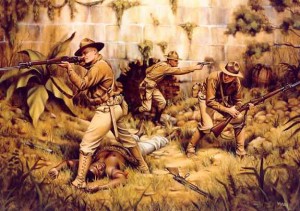From the Marquis’ Commission to an F-86 Kill
This Week in American Military History (originally published at Human Events):
By W. Thomas Smith, Jr.

July 25, 1866: David Glasgow Farragut – best known for purportedly uttering the command, “Damn the torpedoes! Full speed ahead!,” or the more likely command, “Damn the torpedoes! “Four bells. Captain [Percival] Drayton, go ahead! [Lt. Commander James] Jouett, full speed!” during the 1864 Battle of Mobile Bay, Alabama – is appointed to the rank of admiral (the first such rank in U.S. Naval history).
This same day, future American Pres. Ulysses S. Grant becomes the first “full [four star] general” in the history of the U.S. Army.
July 26, 1947: The National Security Act of 1947 – the law reorganizing the post-World War II national defense/intelligence structure of the United States – is passed.
The Act establishes the U.S. Department of Defense, which brings together the Departments of the Army, Navy (including the Marine Corps), the newly established Air Force (born of the World War II-era Army Air Forces), and it makes “official” the Joint Chiefs of Staff.
The Act also establishes the National Security Council (the highest-ranking executive council – composed of the U.S. president, vice president, secretaries of Defense and State, and others – responsible for advising the president on matters related to the integration of domestic, foreign, and military policies affecting national security) and the Central Intelligence Agency (born of a series of predecessor foreign intelligence-gathering/clandestine-operations organizations including the World War II-era Office of Strategic Services).
The Act, which will become effective Sept. 18, is considered to be the most sweeping reorganization of the American defense structure since the establishment of the Department of the Navy in 1798.
July 27, 1909: Aviation pioneer Orville Wright flies himself and U.S. Army Lt. Frank P. Lahm above the Fort Myer, Virginia countryside for more than an hour in his now-famous Wright Flyer. The Army leadership is impressed enough that it takes delivery of its first Wright Flyer, “the world’s first military airplane,” within days.
July 27, 1953: A negotiated ceasefire ends the “shooting war” in Korea. This same day, U.S. Air Force Capt. Ralph S. Parr, flying an F-86 Sabre, shoots down a Soviet Ilyushin Il-12 transport, reportedly “the last kill” of the Korean War.
July 28, 1915: Rear Admiral William B. Caperton, commander of the Cruiser Squadron of the Atlantic Fleet, orders 340 U.S. Marines and sailors ashore at Port au Prince, Haiti. The landing party is composed of the Marine Detachment USS Washington, the 12th Marine Expeditionary Company, and three companies of sailors. More troops will follow.
The landings are initiated in response to a spate of mob violence in which scores of political prisoners are summarily executed.
July 29, 1846: Sailors and Marines of USS Cyane seize San Diego, California, during the Mexican War.
July 30, 1864: In a special-operation that proves disastrous for the initiators, Union Army troops under the command of Maj. Gen. Ambrose E. Burnside detonate a mine, blowing a huge hole (or crater) in the Confederate defenses at Petersburg, Virginia. Several units of Union soldiers charge in after the explosion, but each unit is beaten back with heavy losses by Confederates under Brig. Gen. William Mahone.
July 31, 1777: The Marquis de Lafayette, a 19-year-old French nobleman whom Gen. George Washington will soon take under his wing, is commissioned “major general” in the Continental Army.
Let’s increase awareness of American military tradition and honor America’s greatest heroes by supporting the Medal of Honor Society’s 2010 Convention to be held in Charleston, S.C., Sept. 29 – Oct. 3, 2010 (for more information, click here).